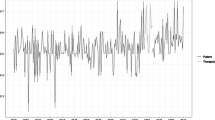Abstract
In the “parallel studies” project led by Carl Rogers at the Counseling Center of the University of Chicago over 70 years ago, measures of personality organization and other clinical ratings were applied to 10 recorded and transcribed cases. This paper applied computerized measures of the referential process to the treatment by Rogers of the client known as Miss Vib. The treatment was considered successful and used by Rogers to illustrate his theory of personality, and his view of the therapeutic process. Using the DAAP system, the measures were applied to therapist and client speech at embedded levels of magnification, including measures for the treatment as a whole to be compared to other treatments in the referential process data base; measures for individual sessions to show progression across the trajectory of a treatment for comparison with the clinical ratings; and measures representing word by word variation within a session to enable close examination of the process. The initial prediction concerning the relation of the referential process measures to the clinical measures was not confirmed. Close examination of pivotal sessions provided an account of the results beyond that emphasized in the client-centered approach.



Similar content being viewed by others
Notes
The Rorschach data did not show a clear relationship with the other measures of change; these data were not used by Rogers and his colleagues in their analysis of the results and are not discussed here.
The specific method of computation of the averages for individual treatments and for the data base as a whole is described by Maskit (2021).
Here as throughout the paper we refer to Miss Vib as the client, as is the practice in client-centered therapy and as ‘C’ in the verbatim examples of dialogue later in this paper. We refer to Dr. Rogers as the therapist (rather than Counselor) and as ‘T’ to avoid confusion in the verbatim examples.
English translation of quotes from Rogers and Kinget taken from Crisafulli (2011).
The numbers in square brackets refer to word count in the session, as indicated on the x-axis of the graph.
References
Bucci, W. (2005). Basic concepts and methods of psychoanalytic process research. In E. Person, A. Cooper, & G. Gabbard (Eds.), Textbook of Psychoanalysis (pp. 339–355). United States: American Psychiatric Press.
Bucci, W. (2007). Dissociation from the perspective of multiple code theory – Part II: The spectrum of dissociative process in the psychoanalytic relationship. Contemporary Psychoanalysis, 43, 305–326.
Bucci, W. (2013). The referential process as a common factor across treatment modalities. Research in Psychotherapy: Psychopathology, Process and Outcome, 16(1), 16. https://doi.org/10.4081/ripppo.2013.86.
Bucci, W. (2021). Overview of the referential process: the operation of language within and between people. Journal of Psycholinguistic Research. https://doi.org/10.1007/s10936-021-09759-2.
Bucci, W., & Maskit, B. (2006). A weighted referential activity dictionary. In J. G. Shanahan, Y. Qu, & J. Wiebe (Eds.), Computing attitude and affect in text: Theory and applications (pp. 49–60). Netherlands: Springer.
Bucci, W., Maskit, B., & Murphy, S. (2016). Connecting emotions and words: The referential process. Phenomenology and Cognitive Science. https://doi.org/10.1007/s11097-015-9417-z,15(3),359-383.
Crisafulli, G. (2011). History and research of a client-centered treatment. Annual Meeting of the American Psychoanalytic Association 2011, New York.
Crits-Cristoph, P., Gibbons, M. C., & Mukherjee, D. (2013). Psychotherapy process-outcome research. In M. Lambert (Ed.), Handbook of psychotherapy and behavior change (6th ed., pp. 298–340). United States: Wiley.
Haigh, G. (1949). Defensive behavior in client-centered therapy. Journal of Consulting Psychology, 13(3), 181–189. https://doi.org/10.1037/h0060646.
Hoffman, A. E. (1949). A study of reported behavior changes in counseling. Journal of Consulting Psychology, 13(3), 190–195. https://doi.org/10.1037/h0054938.
Maskit, B. (2021). Overview of computer measures of the referential process. Journal of Psycholinguistic Research. https://doi.org/10.1007/s10936-021-09761-8.
Matthieu-Coughlan, P., & Klein, M. H. (1984). Experiential psychotherapy: Key events in client-therapist interaction. In L. Rice & L. Greenberg (Eds.), Patterns of change: Intensive analysis of psychotherapy process (pp. 213–248). New York: Guilford.
Raskin, N. J. (1949). The development of the “parallel studies” project. Journal of Consulting Psychology, 13(3), 154–156. https://doi.org/10.1037/h0061751.
Rice, L., & Saperia, E. (1984). Task analysis of the resolution of problematic reactions. In L. Rice & L. Greenberg (Eds.), Patterns of change: Intensive analysis of psychotherapy process (pp. 29–66). New York: Guilford.
Rogers, C. R. (1947). Some observations on the organization of personality. American Psychologist, 2(9), 358–368. https://doi.org/10.1037/h0060883.
Rogers, C. R. (1949). A coordinated research in psychotherapy: A nonobjective introduction. Journal of Consulting Psychology, 13(3), 149–153.
Rogers, C., & Kinget, M. (1965). Psychothérapie et relations humaines. théorie et pratique de la thérapie non-directive. Paris: Editions Béatrice Nauwelaerts.
Rogers, C. R., Gendlin, E. T., Kiesler, D. J., & Truax, C. B. (1967). The therapeutic relationship and its impact: A study of psychotherapy with schizophrenics. Madison: University of Wisconsin Press.
Seeman, J. (1949). A study of the process of nondirective therapy. Journal of Consulting Psychology, 13(3), 157–168. https://doi.org/10.1037/h0056764.
Sheerer, E. T. (1949). An analysis of the relationship between acceptance of and respect for self and acceptance of and respect for others in ten counseling cases. Journal of Consulting Psychology, 13(3), 169–175. https://doi.org/10.1037/h0062262.
Snyder, W. U. (1945). An investigation of the nature of nondirective psychotherapy. Journal of General Psychology, 33, 193–223.
Stock, D. (1949). An investigation into the interrelations between the self concept and feelings directed toward other persons and groups. Journal of Consulting Psychology, 13(3), 176–180. https://doi.org/10.1037/h0059697.
Zhou, Y., Maskit, B., Bucci, W., Fishman, A., & Murphy, S. (2021). Development of WRRL - a new computerized measure of the reflecting/reorganizing function. Journal of Psycholinguistic Research. https://doi.org/10.1007/s10936-021-09762-7.
Author information
Authors and Affiliations
Corresponding author
Additional information
Publisher's Note
Springer Nature remains neutral with regard to jurisdictional claims in published maps and institutional affiliations.
Rights and permissions
About this article
Cite this article
Bucci, W., Crisafulli, G. Linguistic Measures of the Therapeutic Process in Carl Rogers’s Case of Miss Vib. J Psycholinguist Res 50, 169–192 (2021). https://doi.org/10.1007/s10936-021-09769-0
Accepted:
Published:
Issue Date:
DOI: https://doi.org/10.1007/s10936-021-09769-0




